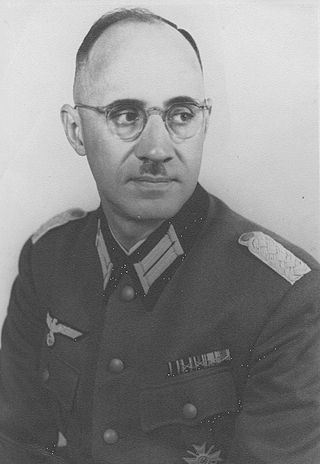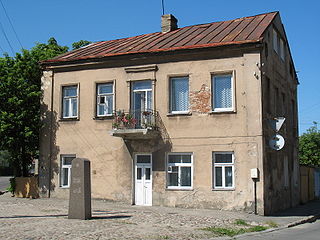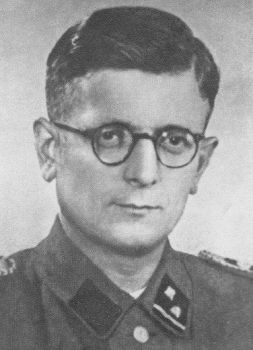Related Research Articles

Karl Plagge was a German Army officer who rescued Jews during the Holocaust in Lithuania by issuing work permits to non-essential workers. A partially disabled veteran of World War I, Plagge studied engineering and joined the Nazi Party in 1931 in hopes of helping Germany rebuild from the economic collapse following the war. After being dismissed from the position of lecturer for being unwilling to teach racism, and his opposition to Nazi racist policies, he stopped participating in party activities in 1935 and left the party when the war broke out.

The Fareynikte Partizaner Organizatsye was a Jewish resistance organization based in the Vilna Ghetto in Lithuania that organized armed resistance against the Nazis during World War II. The clandestine organisation was established by Communist and Zionist partisans. Their leaders were writer Abba Kovner, Josef Glazman and Yitzhak Wittenberg.
Marcinkonys or Marcinkańce Ghetto was a small Jewish ghetto established during the Holocaust in Marcinkonys. It existed from around November 1941 to November 1942 and housed 300 to 400 Jews.

The Kovno Ghetto was a ghetto established by Nazi Germany to hold the Lithuanian Jews of Kaunas during the Holocaust. At its peak, the ghetto held 29,000 people, most of whom were later sent to concentration and extermination camps, or were shot at the Ninth Fort. About 500 Jews escaped from work details and directly from the ghetto, and joined Soviet partisan forces in the distant forests of southeast Lithuania and Belarus.

The Vilna Ghetto was a World War II Jewish ghetto established and operated by Nazi Germany in the city of Vilnius in the modern country of Lithuania, at the time part of the Nazi-administered Reichskommissariat Ostland.

HKP 562 was the site of a Nazi forced labor camp for Jews in Vilnius, Lithuania, during the Holocaust. Located at 47 & 49 Subačiaus Street, in apartment buildings originally built to house poor members of the Jewish community, the camp was used by the German army as a slave labor camp from September 1943 until July 1944. During that interval, the camp was officially owned and administered by the SS, but run on a day-to-day basis by a Wehrmacht engineering unit, Heereskraftfahrpark (HKP) 562, stationed in Vilnius. HKP 562's commanding officer, Major Karl Plagge, was sympathetic to the plight of his Jewish workers. Plagge and some of his men made efforts to protect the Jews of the camp from the murderous intent of the SS. It was partially due to the covert resistance to the Nazi policy of genocide toward the Jews by members of the HKP 562 engineering unit that over 250 Jewish men, women and children survived the final liquidation of the camp in July 1944, the single largest group of Jewish survivors of the Holocaust in Vilnius.
Ypatingasis būrys or Special Squad of the German Security Police and SD was a killing squad operating in the Vilnius Region in years 1941–1944. The unit, primarily composed of Lithuanian volunteers, was formed by the German occupational government and was subordinate to Einsatzkommando 9 and later to Sicherheitsdienst (SD) and Sicherheitspolizei (Sipo). The unit was subordinated to German police, and had no official autonomy. In Polish they are colloquially called strzelcy ponarscy.

The Ponary massacre or the Paneriai massacre was the mass murder of up to 100,000 people, mostly Jews, Poles, and Russians, by German SD and SS and their Lithuanian collaborators, including Ypatingasis būrys killing squads, during World War II and the Holocaust in the Generalbezirk Litauen of Reichskommissariat Ostland. The murders took place between July 1941 and August 1944 near the railway station at Ponary, a suburb of today's Vilnius, Lithuania. 70,000 Jews were murdered at Ponary, along with up to 20,000 Poles, and 8,000 Soviet POWs, most of them from nearby Vilna (Vilnius), and its newly formed Vilna Ghetto.

The Holocaust in Lithuania resulted in the near total destruction of Lithuanian (Litvaks) and Polish Jews, living in Generalbezirk Litauen of Reichskommissariat Ostland within the Nazi-controlled Lithuanian SSR. Out of approximately 208,000–210,000 Jews, an estimated 190,000–195,000 were murdered before the end of World War II, most of them between June and December 1941. More than 95% of Lithuania's Jewish population was massacred over the three-year German occupation – a more complete destruction than befell any other country affected by the Holocaust. Historians attribute this to the massive collaboration in the genocide by the non-Jewish local paramilitaries, though the reasons for this collaboration are still debated. The Holocaust resulted in the largest-ever loss of life in so short a period of time in the history of Lithuania.

Martin Weiss was a Nazi official and de facto commander of the Vilna Ghetto and a Holocaust perpetrator. He was also the commander of the notorious Nazi-sponsored Ypatingasis būrys killing squad, which was largely responsible for the Ponary massacre where approximately 100,000 people were shot.
Mother Bertranda, O.P., later known as Anna Borkowska, was a Polish cloistered Dominican nun who served as the prioress of her monastery in Kolonia Wileńska near Wilno. She was a graduate of the University of Kraków who had entered the monastery after her studies. During World War II, under her leadership, the nuns of the monastery sheltered 17 young Jewish activists from Vilnius Ghetto and helped the Jewish Partisan Organization (FPO) by smuggling weapons. In recognition of this, in 1984 she was awarded the title of Righteous among the Nations by Yad Vashem.

The Šiauliai or Shavli Ghetto was a Jewish ghetto established in July 1941 by Nazi Germany in the city of Šiauliai in Nazi-occupied Lithuania during the Holocaust. The ghetto comprised two areas – one in the Kaukazas suburb and one on Trakai Street. Both were liquidated by July 1944, and their inhabitants were killed or transferred to Nazi concentration camps. In 1939, one quarter of the population of Šiauliai was Jewish, about 8,000 persons. By the end of World War II, only about 500 Jews of the city had survived.

Hirsch Schwartzberg was a Jewish leader of Holocaust survivors under the American occupation of Berlin.
Švenčionys, Svintsyan or Święciany Ghetto was a Jewish ghetto in Nazi-occupied Švenčionys. It operated from July 1941 to April 1943. At its peak, the ghetto housed some 1,500 prisoners. It was located in what today is a city park; the location is marked by a wooden menorah carved by Juozapas Jakštas.

The Lithuanian Auxiliary Police Battalions were Schutzmannschaft battalions formed during the German occupation of Lithuania between 1941 and 1944, with the first battalions originating from the most reliable freedom fighters that were disbanded following the anti-Soviet Lithuanian June Uprising in 1941. Lithuanian activists hoped that these units would be the basis of the reestablished Lithuanian Army and commanded by the Lithuanian Provisional Government. Instead, these units were placed under the orders of the SS- und Polizeiführer in Lithuania. The battalions were charged with internal security duties and engaged in anti-partisan operations in the Wehrmacht's rear areas, e.g. Ukraine, Belarus, Poland and Northwest Russia.
Jacob Gens was the head of the Vilnius Ghetto government. Originally from a merchant family, he joined the Lithuanian Army shortly after the independence of Lithuania, rising to the rank of captain while also securing a college degree in law and economics. He married a non-Jew and worked at several jobs, including as a teacher, accountant, and administrator.
Josef Glazman was a Lithuanian-Jewish resistance leader in the Vilna Ghetto. A member of the Revisionist Zionism movement prior to the German invasion of the Baltic states in 1941, afterwards he took part in resistance and youth movements in the ghetto. He also worked in the Jewish-run ghetto administration – first in the police, then later in the housing department. Glazman's relationship with the head of the ghetto, Jacob Gens, was difficult and led to Glazman's arrest several times. Eventually Glazman left the ghetto with a group of followers and formed a partisan unit in the Lithuanian forests. His partisan band was surrounded in October 1943 and Glazman and all but one of the members were killed by the Germans.

Kailis forced labor camp was a Nazi labor camp for Jews in Vilnius during World War II. It was based on a pre-war fur and leather factory and mostly produced winter clothing for the German military. At its peak, after the liquidation of the Vilna Ghetto in September 1943, the camp housed about 1,500 Jews. The camp was liquidated and its workers executed at Ponary on 3 July 1944, just ten days before Red Army captured the city.
Rudolf Neugebauer was a German SS Hauptsturmführer during the Nazi era. He served as the head of the Vilnius Gestapo in German-occupied Lithuania and personally killed Jacob Gens.
References
- 1 2 3 4 5 "Bruno Kittel (1922 – untergetaucht 1945)". Gedenkorte Europa (in German). Studienkreises Deutscher Widerstand 1933–1945. Retrieved 25 June 2017.
- 1 2 3 Ehrenburg, Ilya; Grossman, Vasily (2009). Patterson, David (ed.). The Complete Black Book of Russian Jewry (4th ed.). Transaction Publishers. p. 258. ISBN 978-0-7658-0543-0.
- 1 2 3 Arad, Yitshak (1980). Ghetto in Flames: The Struggle and Destruction of the Jews in Vilna in the Holocaust. Jerusalem: Yad Vashem Martyrs' and Heroes' Remembrance Authority. pp. 368–369. OCLC 499443649.
- ↑ Bubnys, Arūnas (2011). "Vilniaus žydų žudynės ir Vilniaus getas". Holokaustas Lietuvoje 1941–1944 m. (in Lithuanian). Lietuvos gyventojų genocido ir rezistencijos tyrimų centras. p. 36. ISBN 978-609-8037-13-5.
- ↑ Midlarsky, Manus I. (2005). The Killing Trap: Genocide in the Twentieth Century . Cambridge University Press. p. 302. ISBN 978-0521894692.
- ↑ Arad Ghetto in Flames, pp. 399–401
- ↑ Gilbert, Martin (2002). The Routledge Atlas of the Holocaust (3rd ed.). Routledge. p. 163. ISBN 0-415-28145-8.
- ↑ Voren, Robert van (2011). Undigested Past: The Holocaust in Lithuania. Rodopi. p. 104. ISBN 978-90-420-3371-9.
- ↑ Bubnys Vilniaus žydų žudynės ir Vilniaus getas, p. 50
- 1 2 Bubnys Vilniaus žydų žudynės ir Vilniaus getas, pp. 41–43
- ↑ Buttar, Prit (2013). Between Giants: The Battle for the Baltics in World War II. Osprey Publishing. pp. 123–124. ISBN 978-1-78096-163-7.
- ↑ Kassow, Samuel D. (2014). The Clandestine History of the Kovno Jewish Ghetto Police. Indiana University Press. pp. 2–3. ISBN 978-0-253-01283-8.